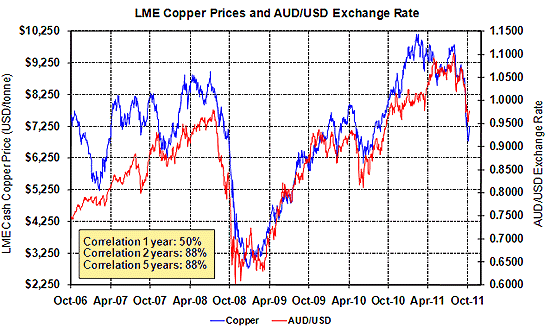
 By Roger J Kerr
By Roger J Kerr
A consolidation period for the Kiwi dollar has to be expected over coming weeks following the 13 cents plummet from 0.8800 in early August to lows of 0.7470 last week.
The speed and momentum of NZ dollar plunges such as these cannot be too surprising, as it has happened many times before that offshore players / speculators in our currency always seem to forget that the exit door is not that large when they are all rushing to get out - that is, the liquidity of the NZD market cannot handle massive one-sided selling.
As a consequence, the pricing in the inter-bank NZD/USD forex market gaps down in an attempt to find some brave Kiwi dollar buyers.
The close link the NZ dollar has to the Australian dollar remains as the major reason for the NZD sell-down against the USD to these mid-0.7000 levels.
The once bullish and cocky mood towards the Australian economy and currency of just a few short months ago has turned sour very quickly.
Basically, a combination of their previous high AUD value against the USD above $1.0000 did enormous damage to their non-resources export and manufacturing sectors. The weaker economic figures coming out of Australia over recent months seem to be a direct consequence of their previous over-valued currency value.
More latterly, the falling PMI manufacturing indices around the globe have pulled hard commodity prices lower, which is always negative for the AUD.
Last week we had the first signal from the Reserve Bank of Australia that they could lower official interest rates as inflationary risks wane. Back two months ago the interest rate markets in Australia were pricing-in future interest rate cuts of up to 1.00% over the next 12 months.
The Australian dollar forex market ignored that interest rate market pessimism on the Australian economy for a period and still priced the AUD higher. That situation has now changed with the FX markets succumbing to the prospect of lower Australian interest rates no longer making the AUD an attractive currency to hold.
At the same time, the international currency market sentiment has swung in favour of the safe/reserve currency, the US dollar, as turmoil engulfed Europe and investors sought the safe haven USD.
The NZD and AUD are both sharply lower against the USD as the USD has strengthened 8% from $1.4500 to $1.3300 against the Euro.
The immediate outlook for the AUD has to be for further weakness towards 0.9500, which would lower the NZD/USD rate from 0.7700 to 0.7500 again. Australian jobs numbers this Thursday are likely to be weaker again, with consumer and business confidence surveys also likely to print on the weaker side this week.
The Australian currency had a dream run up from March 2009 to March 2011 as the world re-stocked and commodity prices soared, today the environment has changed dramatically with all the lead-indicators for the AUD now firmly turned downwards. The copper price is an accurate lead for the AUD/USD arte and it remains in a clear downtrend in the commodity markets.

On top of the sovereign credit rating downgrade, all New Zealand’s currency lead-indicators are also pointing downwards.
Wholemilk powder dairy prices continue to fall on the fortnightly Global Dairy Trade auctions. Fonterra were hoping for some price stabilisation at the lower levels, however there is no evidence of this happening as yet as supply currently out-strips demand. Adding to the milk powder supply situation is a record seasonal “super-flush” in the local dairy industry as great climatic conditions boost grass growth and milk flows.
The ANZ Commodity Price Index is now recording nearly all our agricultural commodity prices falling on international markets as global demand weakens.
The depreciation of the NZD was inevitable as it had to catch up to price falls in wholemilk powder prices which had been falling sharply since June. The NZ dollar remains very vulnerable to all the mini-shocks that are hitting global equity markets which encourages more investors to be in “risk-off” mode.
The New Zealand economy desperately needed a weaker currency to have any opportunity to get GDP growth going again in the next 12 months.
Exporters should have more confidence to invest and expand output at 0.7500, because they sure did not have that confidence at a 0.8500 exchange rate value.
Looking ahead continuing Euro weakness, still falling global commodity prices and volatile global sharemarkets look set to weigh the NZ dollar lower still. At what point the NZD/USD exchange rate finds a firmer bottom remains to be seen, however only confirmation of a global double-dip recession would push it below 0.7000. Therefore, the Kiwi dollar seems more likely to spend some time in the low 0.7000’s before the prospect of increasing NZ interest rates in mid-2012 starts to lift its fortunes again.
The aforementioned scenario is predicated on the view that the global double-dip recession is avoided and the hedge funds finally end their speculation again European banks and bond markets. The main reason the NZD/USD rate can still depreciate up to five cents lower over coming weeks is the EUR/USD rate falling away to below $1.3000 as the economic/market/debt news out of Europe gets worse before it finally stabilises.
No chart with that title exists.
--------------------
* Roger J Kerr runs Asia Pacific Risk Management. He specialises in fixed interest securities and is a commentator on economics and markets. More commentary and useful information on fixed interest investing can be found at rogeradvice.com
2 Comments
Roger,
The ECRI, a quite conservative and reasonably accurate research institute has already called the US recession as started.
Although much of your analysis seems good I have two counter points.
1. There is so much money in the system and everyone is desparately looking for a return so it seems the main risk drivers are still fundamentally in place.
2. Whilst the exchange rate may settle at a lower level for manufacturers you did not discuss the issue of volatiity, which kills long term invertment regardless of the current rate.
Lastly, I cannot help notice in the long run a devaluing currency is a devaluing standard of economic living. Perhaps we should temper our joy for it.
Spoke to a lecturer in finance at Macau university yesterday who told me he had been talking to FX dealers here in HK who reckon the Oz dollar's decline is a temporary phenomenon and will head to $1.40 against the US and ultimately hit $1.60. No time scale was mentioned though. Hope the kiwi is not dragged through all this if it pans out as I've been told. It won't be good for anyone, especially if oil in decent quantities is found in our coastal waters - will push up our exchange rate and kill agricultural and timber exports.




We welcome your comments below. If you are not already registered, please register to comment.
Remember we welcome robust, respectful and insightful debate. We don't welcome abusive or defamatory comments and will de-register those repeatedly making such comments. Our current comment policy is here.